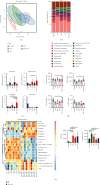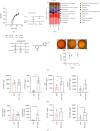The Role of Dihydroresveratrol in Enhancing the Synergistic Effect of Ligilactobacillus salivarius Li01 and Resveratrol in Ameliorating Colitis in Mice
- PMID: 35935130
- PMCID: PMC9275091
- DOI: 10.34133/2022/9863845
The Role of Dihydroresveratrol in Enhancing the Synergistic Effect of Ligilactobacillus salivarius Li01 and Resveratrol in Ameliorating Colitis in Mice
Abstract
Currently approved therapeutical strategies for inflammatory bowel diseases (IBD) suffer from variable efficacy and association with risk of serious side effects. Therefore, efforts have been made in searching for alternative therapeutics strategies utilizing gut microbiota manipulation. In this study, we show that the probiotic strain Ligilactobacillus salivarius Li01 (Li01) and the phytochemical prebiotic resveratrol (RSV) have synergistic effect in ameliorating colitis in mice. Oral coadministration of Li01 (109 CFU/d) and RSV (1.5 g/kg/d) promoted restoration of various inflammatory injuries and gut microbiota composition, exhibiting a favorable anti-inflammatory effect in DSS-induced colitis mice. The combination treatment was associated with reductions in the levels of proinflammatory cytokines IL-1β and IL-6 and increases in the levels of the anti-inflammatory cytokine IL-17A in mouse serum. Moreover, the combination treatment was found to alter the composition and metabolism of the gut microbiota, especially influencing the production of short chain fatty acids and anti-inflammatory related molecules. The mechanism underlying the improved anti-inflammatory effect from the RSV and Li01 combination treatment was found to be associated with the environmental sensor mammalian aryl hydrocarbon receptor (AHR) and tryptophan metabolism pathway. Administration of RSV in combination with Li01 in different mouse model led to enhanced conversion of RSV into metabolites, including dihydroresveratrol (DHR), resveratrol-sulfate, and resveratrol-glucuronide. DHR was found to be the dominant metabolite of RSV in conventional and colitis mice. An increased DHR/RSV ratio was confirmed to activate AHR and contribute to an enhanced anti-inflammatory effect. DHR is considered as a potential AHR ligand. The DHR/RSV ratio also affected the serotonin pathway by controlling the expression of Tph1, SERT, and 5-HT7R leading to amelioration of colitis in mice. Our data suggest that treatment with a combination of Li01 and RSV has potential as a therapeutic strategy for IBD; further investigation of this combination in clinical settings is warranted.
Copyright © 2022 Yiqiu Fei et al.
Conflict of interest statement
The authors declare that there is no conflict of interest regarding the publication of this article.
Figures






Similar articles
-
Impact of Ligilactobacillus salivarius Li01 on benzo[a]pyrene-induced colitis, based on host-microbiome interactions in Mongolian gerbils.Front Nutr. 2025 Feb 26;12:1494525. doi: 10.3389/fnut.2025.1494525. eCollection 2025. Front Nutr. 2025. PMID: 40078411 Free PMC article.
-
Gut Microbiota Composition in Relation to the Metabolism of Oral Administrated Resveratrol.Nutrients. 2022 Feb 28;14(5):1013. doi: 10.3390/nu14051013. Nutrients. 2022. PMID: 35267988 Free PMC article.
-
Prevention of Loperamide-Induced Constipation in Mice and Alteration of 5-Hydroxytryotamine Signaling by Ligilactobacillus salivarius Li01.Nutrients. 2022 Oct 1;14(19):4083. doi: 10.3390/nu14194083. Nutrients. 2022. PMID: 36235735 Free PMC article.
-
Caspase recruitment domain 9, microbiota, and tryptophan metabolism: dangerous liaisons in inflammatory bowel diseases.Curr Opin Clin Nutr Metab Care. 2017 Jul;20(4):243-247. doi: 10.1097/MCO.0000000000000382. Curr Opin Clin Nutr Metab Care. 2017. PMID: 28399013 Review.
-
The Aryl Hydrocarbon Receptor (AHR) as a Potential Target for the Control of Intestinal Inflammation: Insights from an Immune and Bacteria Sensor Receptor.Clin Rev Allergy Immunol. 2020 Dec;59(3):382-390. doi: 10.1007/s12016-020-08789-3. Clin Rev Allergy Immunol. 2020. PMID: 32279195 Review.
Cited by
-
In-Depth Metaproteomics Analysis of Oral Microbiome for Lung Cancer.Research (Wash D C). 2022 Oct 13;2022:9781578. doi: 10.34133/2022/9781578. eCollection 2022. Research (Wash D C). 2022. PMID: 36320634 Free PMC article.
-
Sedanolide alleviates DSS-induced colitis by modulating the intestinal FXR-SMPD3 pathway in mice.J Adv Res. 2025 Mar;69:413-426. doi: 10.1016/j.jare.2024.03.026. Epub 2024 Apr 4. J Adv Res. 2025. PMID: 38582300 Free PMC article.
-
Exploring the distinctive characteristics of gut microbiota across different horse breeds and ages using metataxonomics.Front Cell Infect Microbiol. 2025 Jul 7;15:1590839. doi: 10.3389/fcimb.2025.1590839. eCollection 2025. Front Cell Infect Microbiol. 2025. PMID: 40692682 Free PMC article.
-
Therapeutic Potential and Predictive Pharmaceutical Modeling of Stilbenes in Cannabis sativa.Pharmaceutics. 2023 Jul 12;15(7):1941. doi: 10.3390/pharmaceutics15071941. Pharmaceutics. 2023. PMID: 37514127 Free PMC article. Review.
-
Impact of Ligilactobacillus salivarius Li01 on benzo[a]pyrene-induced colitis, based on host-microbiome interactions in Mongolian gerbils.Front Nutr. 2025 Feb 26;12:1494525. doi: 10.3389/fnut.2025.1494525. eCollection 2025. Front Nutr. 2025. PMID: 40078411 Free PMC article.
References
LinkOut - more resources
Full Text Sources

